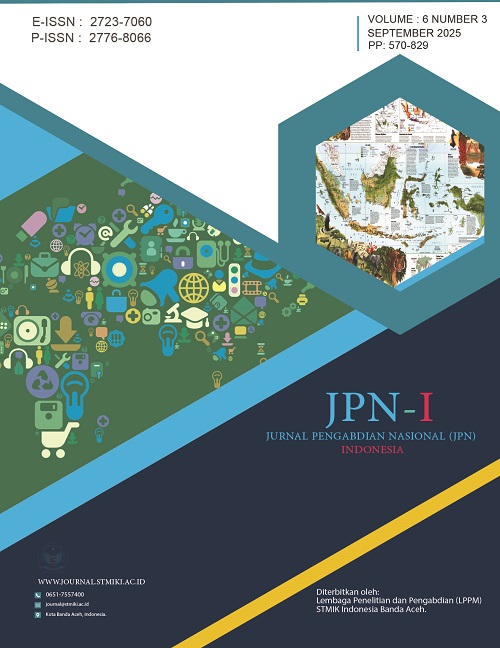Pengembangan Strategi Pemasaran 4C sebagai Upaya Meningkatkan Kunjungan Pasien ke Poli OBGYN Rumah Sakit Tingkat IV Samarinda
Main Article Content
Abstract
Article Summary
This study aims to analyze the implementation of the 4C marketing strategy—Co-creation, Currency, Communal Activation, and Conversation—in increasing patient visits, particularly among pregnant women covered by the BPJS national health insurance program, to the Obgyn Clinic at Level IV Hospital Samarinda through 4D ultrasound services. These services are positioned as a flagship offering, providing vivid fetal imaging experiences at no additional cost, thereby enhancing the hospital's appeal amidst competition in health services. The research employed a descriptive qualitative approach, with data collected through structured interviews involving hospital management, medical personnel, and patients. It was further supported by quantitative data obtained from questionnaires distributed to 40 pregnant patients. The findings indicate that the Co-creation dimension fosters active patient participation through direct communication and engagement in interpreting ultrasound results. The Currency dimension was perceived very positively, as patients felt they received high-value services without extra charges. Communal Activation strategies through health cadres, social media, and maternal support groups were effective in raising awareness and interest in the 4D ultrasound services. Meanwhile, the Conversation dimension, encompassing both face-to-face and digital interactions, played a vital role in building trust and long-term patient loyalty. Based on these findings, the 4C marketing strategy has proven to be relevant and effective when implemented in National Health Insurance-based hospital services, with an increasing trend in average patient visits from 180 patients per month to 220 patients per month (a 22% increase). This study recommends the use of mixed methods in future research to obtain a more complete understanding of how each dimension influences patient visitation behavior.
Downloads
Article Details

This work is licensed under a Creative Commons Attribution-NonCommercial-ShareAlike 4.0 International License.
References
Andita, D., Nugraha, I., & Suryanegara, M. (2019). Efisiensi pelayanan rumah sakit. Jurnal Manajemen Kesehatan, 7(2), 45–56.
Armstrong, G., Kotler, P., Harker, M., & Brennan, R. (2014). Marketing: An introduction (12th ed.). Pearson Education.
Badruddin, H., Ilyas, J., & Sulistiadi, W. (2022). Strategi branding dalam pemasaran di rumah sakit. Jurnal Kesehatan Masyarakat, 10(2), 229–232. https://doi.org/10.14710/jkm.v10i2.32774
Bandaso, A., Kusumowardhan, D., Tanjung, H. P., Marliani, L., & Mokoginta, M. (2020). Strategi Place dalam Pemasaran Rumah Sakit di Indonesia; Systematic Review. Jurnal ARSI (Administrasi Rumah Sakit Indonesia), 6(3), 1. https://doi.org/10.7454/arsi.v6i3.3560
Budiman, M. E. A., Mardijanto, S., & Astutik, E. E. (2021). Hubungan Kepuasan Pasien Rawat Inap Dengan Mutu Pelayanan Keperawatan Di Klinik Kabupaten Jember. Jurnal Riset Manajemen Dan Bisnis, 15(2), 73-84.
Cahyani, W. D. (2024). Analisis pelayanan pasien rawat jalan di poli OBGYN rumah sakit dalam upaya peningkatan kualitas layanan dan kepuasan pasien (serta keluarga pasien): Literature review. Jurnal Kesehatan Tambusai, 5(2), 4410–4419. https://doi.org/10.31004/jkt.v5i2.28774
Eugene Fibuch, M. D., & Arif Ahmed, B. D. S. (2016). Branding health care: important or just marketing?. Physician Leadership Journal, 3(4), 30.
Farty, H. H. (2023). Pengaruh strategi pemasaran 4C terhadap minat kunjungan ulang pasien poliklinik RSUD Hajjah Andi Depu Hajjah Polewali Mandar Sulawesi Barat [Skripsi, Universitas Hasanuddin]. Repository Universitas Hasanuddin. https://repository.unhas.ac.id/id/eprint/30175
Fatihudin, D., & Firmansyah, M. A. (2019). Pemasaran jasa: Strategi, mengukur kepuasan, dan loyalitas pelanggan. Deepublish. https://repository.um-surabaya.ac.id/id/eprint/3361/
Huda, A. M., & Martanti, D. E. (2018). Pengantar manajemen strategik. Jayapangus Press Books.
Imaningsih, E. S., & Rohman, S. (2018). The model of product quality, promotion, price, and purchase decisions. Jurnal Ekonomi, 23(2). https://doi.org/10.24912/je.v23i2.373
Indrasari, M. (2019). Pemasaran dan kepuasan pelanggan. Unitomo Press.
Julianti, D., Sari, E., & Wahyuni, T. (2022). Penerapan digital marketing dalam meningkatkan citra rumah sakit. Jurnal Bisnis Digital, 3(1), 10–22.
Kotler, P., & Armstrong, G. (2018). Principles of marketing (17th ed.). Pearson.
Kotler, P., & Keller, K. L. (2022). Marketing management (16th ed.). Pearson.
Moleong, L. J. (2020). Metodologi penelitian kualitatif (Ed. Revisi). Remaja Rosdakarya.
Nadiyah, S. N. A., & Prayoga, D. (2024). Transformasi Digital Sebagai Bagian dari Strategi Pemasaran Rumah Sakit: Literature Review. Media Publikasi Promosi Kesehatan Indonesia (MPPKI), 7(2), 265-272. https://doi.org/10.56338/mppki.v7i2.4283
Novitasari, E. (2020). Dasar-dasar ilmu manajemen: Pengantar menguasai ilmu manajemen. Anak Hebat Indonesia.
Nurfitriani, S., Paradilla, M., Niartiningsih, A., & Takwa, M. (2024). Patient experience teori dan praktek. Uwais Inspirasi Indonesia.
Nurmalawati, N. (2024). Pengaruh kualitas layanan dan fasilitas rumah sakit terhadap kepuasan pasien rawat inap dengan kepercayaan pasien sebagai variabel intervening [Tesis, Universitas Hasanuddin]. Repository Universitas Hasanuddin. https://repository.unhas.ac.id/id/eprint/34776
Pujiyanto, P. (2022). Analisis Rancangan Strategi Marketing Rumah Sakit Dalam Upaya Meningkatkan Angka Kunjungan Pasien Tindakan Mata RS Mata Bandung Eye Center. Syntax Literate; Jurnal Ilmiah Indonesia, 7(10), 18428-18435.
Suprayitno, D., Ahmad, A., Tartila, T., Sa'dianoor, S. D., & Aladdin, Y. A. (2024). METODOLOGI PENELITIAN KUALITATIF: Teori Komprehensif dan Referensi Wajib bagi Peneliti. PT. Sonpedia Publishing Indonesia.

